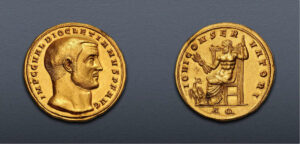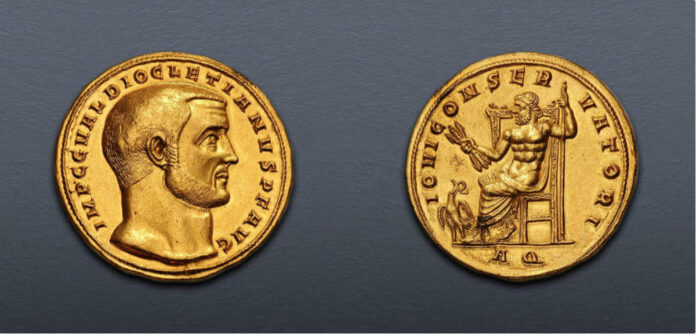Largest Roman Gold Coin Ever Offered Tops Triton XXVI Auction
The largest Roman gold coin ever offered at auction, a unique 10-aureus gold medallion of the Emperor Diocletian, tops the ancient and world coin offerings in Classical Numismatic Group LLC’s Triton XXVI auction slated for January 10-11, 2023, in conjunction with the New York International Numismatic Convention.

The huge gold piece, termed a denio by specialists, is nearly 40mm in diameter and weighs 53.75 grams, larger in diameter and nearly twice the weight of a U.S. “double eagle.” It is believed to have been struck in AD 294 to mark Diocletian’s tenth anniversary of rule, according to Paul Hill, Senior Numismatist for CNG’s London office. It will be offered as Lot 830 in Triton XXVI, with an estimate of $500,000.
The Diocletian denio has been authenticated and graded by Numismatic Guaranty Corporation, achieving an extraordinary grade of Choice AU★, Strike: 5/5, Surface 5/5, Fine Style. It is easily the largest Roman gold piece ever certified by NGC. “NGC Ancients is pleased to have handled this exciting piece, which stands out as one of the finest Roman medallions in existence,” said David Vagi, NGC’s Director of Ancient Coins.
“The coin is spectacular not only for its immense size and weight, it is also a superior work of art,” Hill said. “Add to that the historical value of this medallion, struck at a key point in the conflict between paganism and Christianity, and you have one of the most significant Roman coins ever offered at auction.”
“CNG is very gratified the collector who owns this amazing piece chose to consign with us,” said Michael Gasvoda, Managing Director. “This coin is joined by many more outstanding and historically important pieces in our twenty-sixth Triton auction in New York, which will be one of the most important and memorable auctions in CNG’s nearly five-decades in operation.”
Diocletian, who reigned AD 284 – 305, is famous as the emperor who restored order to the Roman Empire after decades of anarchy, and as the ruler who launched the Great Persecution, a last-ditch effort to exterminate Christianity. The 10-aureus medallion, struck at the midway point of his two-decade rule, was created as a special handout to an important military officer or politician as a reward for loyalty and service. “The subtext of a coin representing “ten gold aurei for a decade of rule” would have been obvious to the receiver,” Hill noted.
The medallion depicts a bare head of Diocletian on the obverse, with close-cropped hair and beard in the military style of the third century AD “soldier emperors,” with the legend IMP C G VAL DIOCLETIANVS AVG (“Imperator [Emperor] Caesar Gaius Valerius Diocletianus Augustus”). The reverse depicts the god Jupiter seated left on a throne, holding a thunderbolt in his right hand and a scepter in his left, with an eagle at his feet, clutching a laurel wreath in its beak. The legend reads IOVI CONSERVATORI – “Jupiter the Protector.” The letters A Q beneath the throne indicate the coin was struck at the mint of Aquileia on the north-eastern coast of Italy, near present-day Venice. All other surviving gold medallions of this mint, none approaching this size, were struck much later in the Empire, after circa AD 350.
“Jupiter, the king of the Roman pantheon of deities, was chosen by Diocletian as his personal guardian,” Hill said. “He had restored order to the Roman world in part by sharing his rule with three other men, Maximian, Galerius and Constantius, an arrangement called the Tetrarchy. But Diocletian remained the senior emperor that the other three deferred to, just as all other Roman deities all bowed to Jupiter.”
“I find the portrait of Diocletian on this medallion to be almost mesmerizing in its power,” Gasvoda added. “The engraver of the dies used to strike this piece was a supremely talented artist, able to convey the man’s forceful personality with a marvelous economy of line.”
Only a handful of other ten-aureus medallions are known to exist, all of them in museums or institutional collections. “All known gold denios date to the period of the Tetrarchy. As far as we have been able to determine, this is the only medallion of this size and weight ever brought to auction,” Hill said.
Sessions One through Four of Triton XXVI, comprising 1,316 lots of Ancient, World, and British coinage with a total estimate of $7.5 million, will be held live at the InterContinental Barclay Hotel in New York City on January 10 and 11, 2023.
CNG’s flagship sale features Greek, Celtic, Oriental Greek, Central Asian, Roman Provincial, Roman Republican and Imperatorial, and Roman Imperial coinage. Additionally, there are featured selections of Byzantine, Early Medieval, Islamic, World coinage and medals, and British coinage and medals.
Triton XXVI is highlighted by a number of collections and individual rarities, which make up the majority of coins on offer:
- Ancient Coins from the Pythagoras and S & S Collections
- Greek Coins from the North River Collection
- Greek and Roman Coins from the DMS Collection
- Published Akragas Tetradrachm from the Bibliothèque Nationale de France
- An Exceptional Zoilos I Dikaios Tetradrachm
- Extremely Rare Lucius Munatius Plancus Aureus of Mark Antony
- Third Known Uranius Antoninus Denarius
- Impressive Diocletian Gold Medallion of Ten Aurei
- Gold Franc à pied of Guillaume de la Garde, Archbishop of Arles
- Exceptional Mughal Rarities, including Jahangir’s Spectacular “Cambay Tanka”
- A Collection of British Celtic Coins
- 1893 Proof Five Pounds of Queen Victoria in PF 66 Ultra Cameo
- Impressive Henry VIII Sovereign
- Mint State Elizabethan Ship Ryal
Catalogs for Triton XXVI will be mailed to the active mailing list shortly. Bidding is now open on the site.
View all coins offered in the online catalog.
For further information, visit the CNG website.







